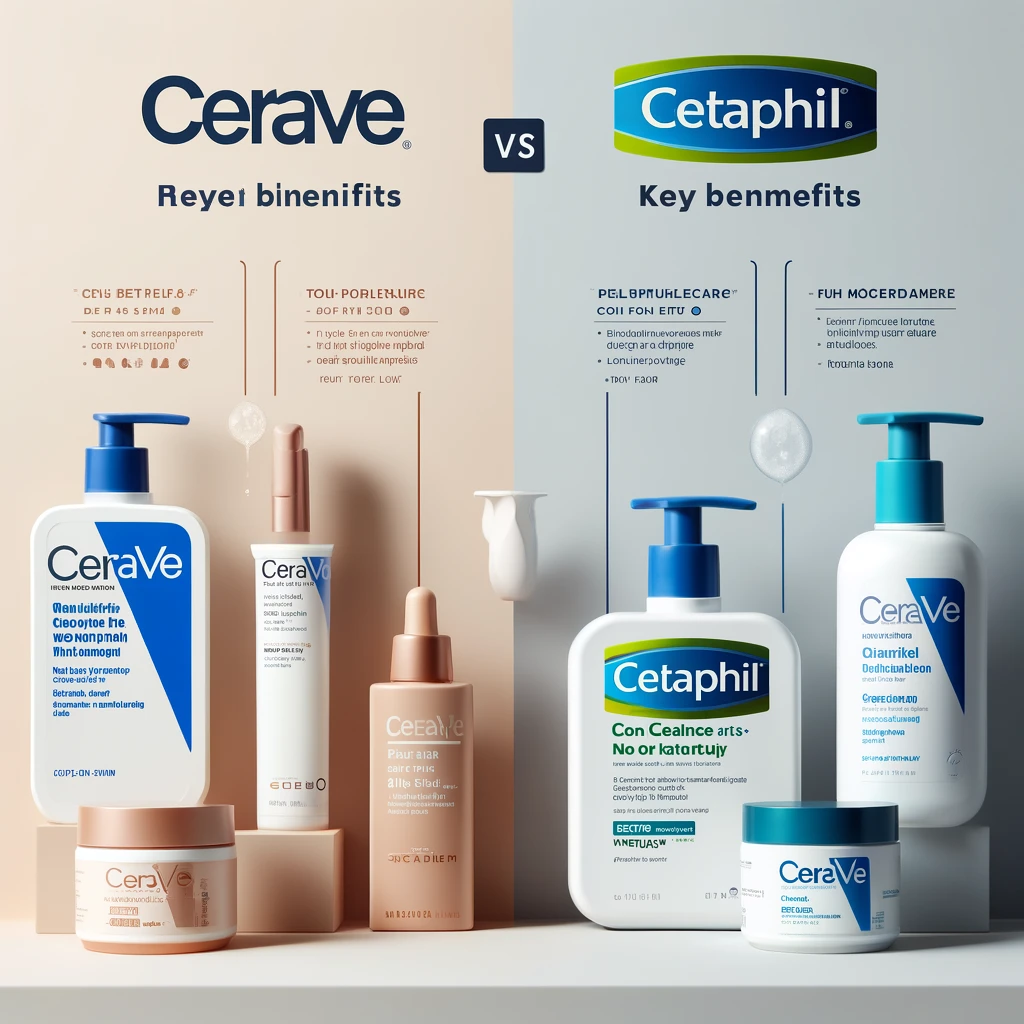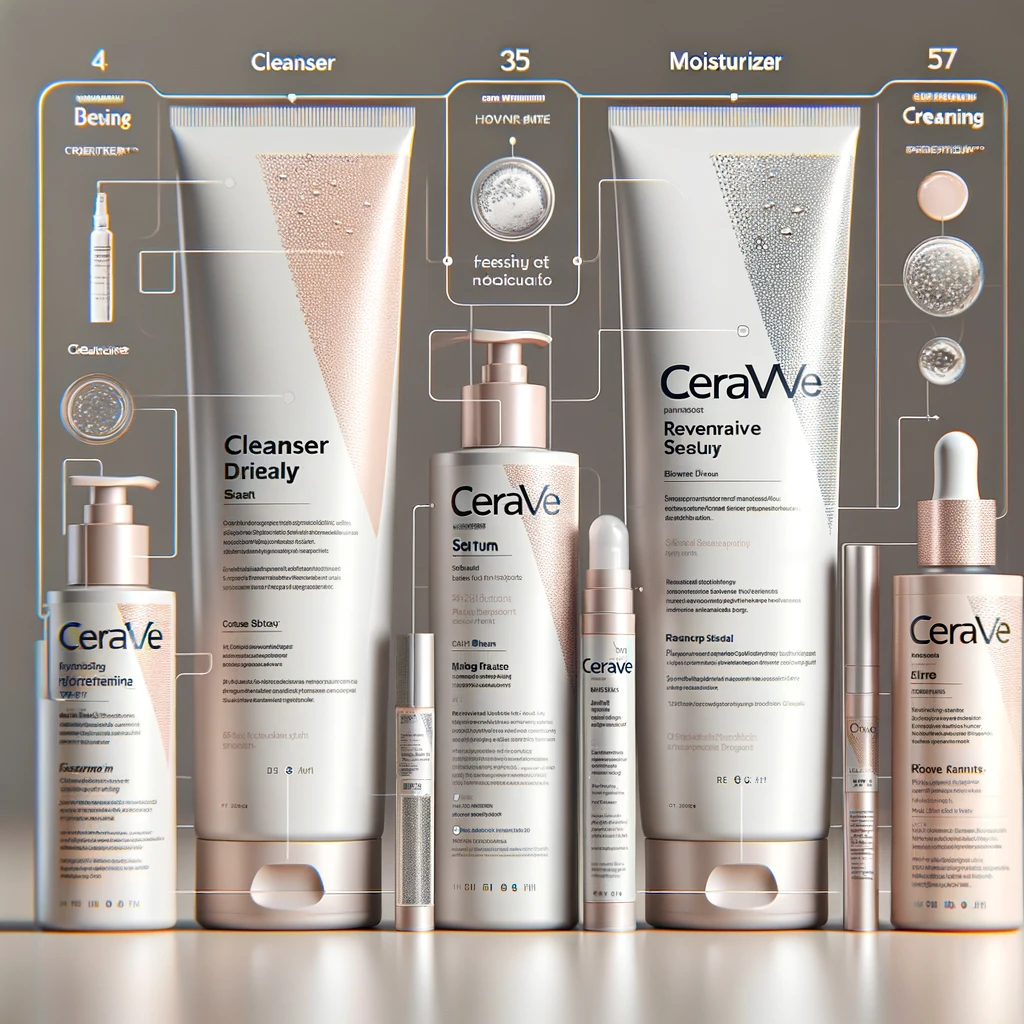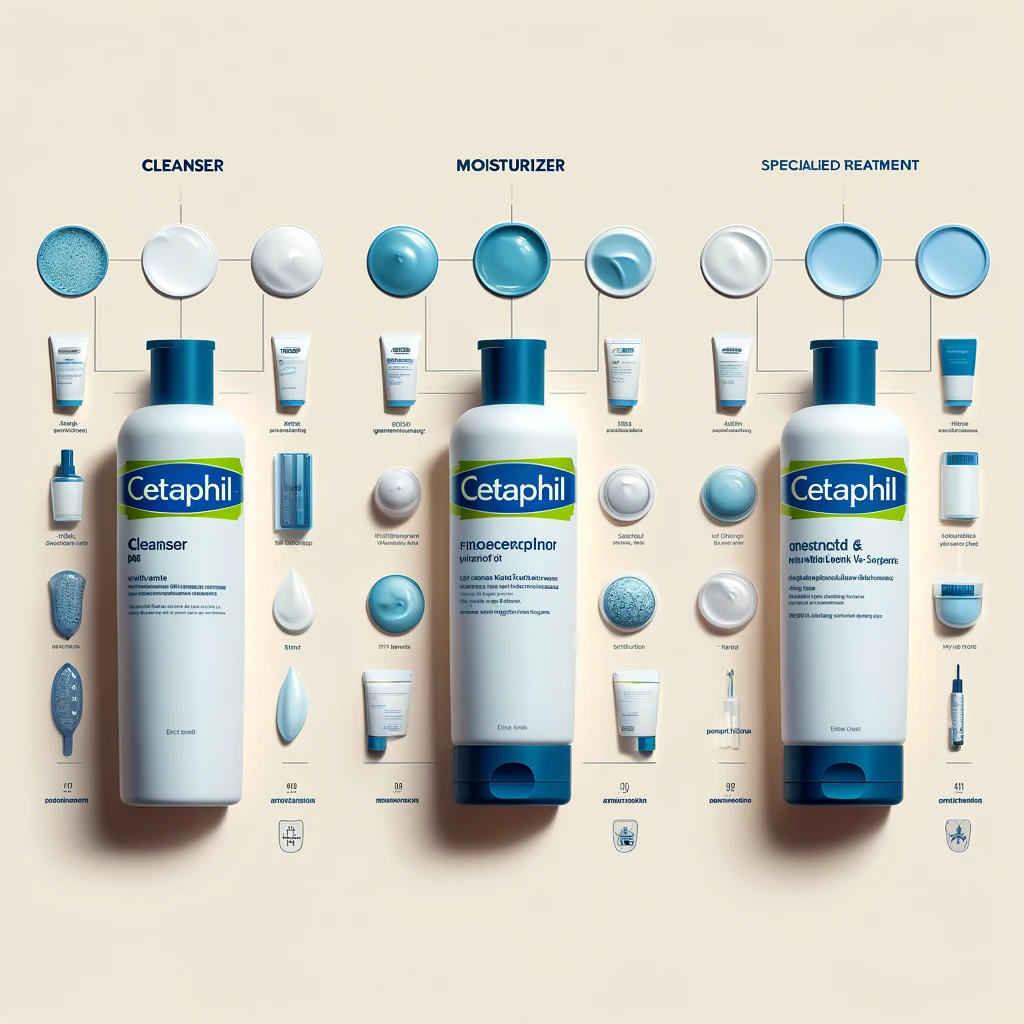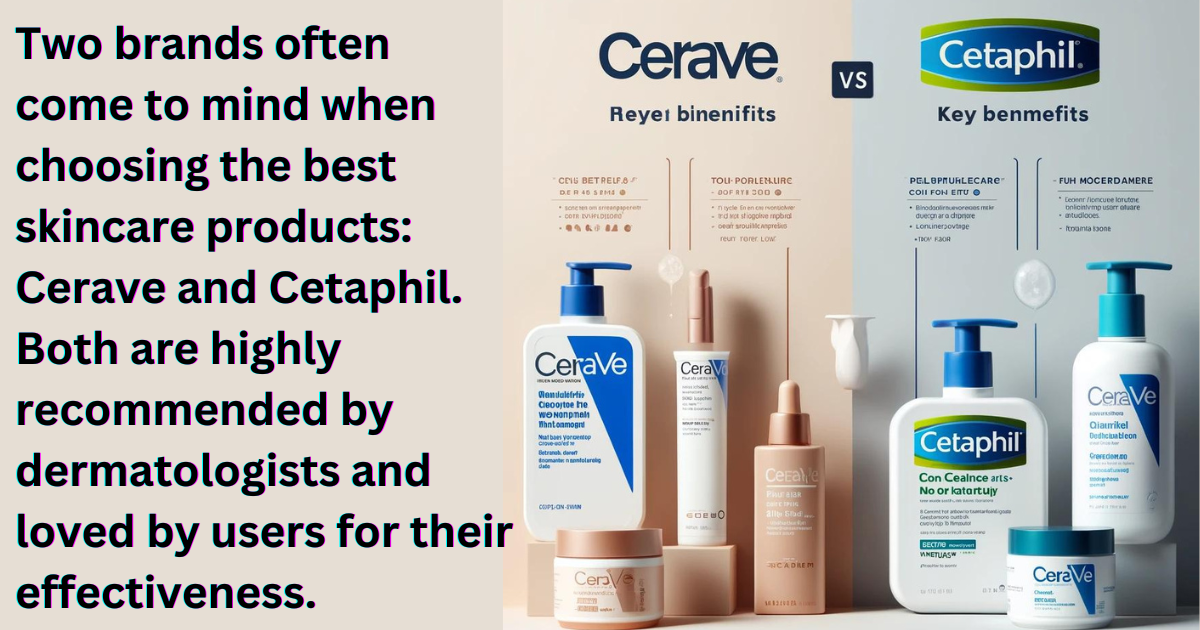Two brands often come to mind when choosing the best skincare products: Cerave and Cetaphil. Both are highly recommended by dermatologists and loved by users for their effectiveness. But how do you decide which one is right for your skin? This post will dive deep into the Cerave vs Cetaphil debate, comparing their products, ingredients, benefits, and user experiences.

Table of Contents
Introduction to Cerave vs Cetaphil
Cerave and Cetaphil are two of the most popular skincare brands. Both offer a range of products designed to address various skin concerns. Understanding these brands’ core philosophies and product lines is essential for making an informed choice.
Cerave: Launched in 2005, Cerave’s products are formulated with dermatologists and contain essential ceramides that help restore the skin’s natural barrier. Their unique delivery system, MultiVesicular Emulsion Technology, ensures that ingredients are released over time for long-lasting hydration.
Cetaphil: Cetaphil has been around since 1947 and is known for its gentle and effective formulations. The brand focuses on providing products suitable for sensitive skin and is committed to simplicity and effectiveness.
What Makes Cerave Stand Out?
Cerave is known for its unique formula that includes essential ceramides and hyaluronic acid. These ingredients help restore the skin’s natural barrier and provide long-lasting hydration. Cerave offers a range of products, including cleansers, moisturizers, and serums.
Key Benefits of Cerave:
- Ceramides: Helps restore and maintain the skin’s natural barrier.
- Hyaluronic Acid: Provides hydration to the skin.
- Non-comedogenic: Won’t clog pores.
- Fragrance-Free: Suitable for sensitive skin.
Popular Cerave Products:
- Cerave Hydrating Cleanser: Ideal for normal to dry skin, this cleanser removes dirt and oil without stripping the skin of its natural moisture.
- Cerave Moisturizing Cream: A rich, non-greasy formula that provides 24-hour hydration.
- Cerave Foaming Facial Cleanser: Perfect for normal to oily skin, this cleanser removes excess oil while maintaining the skin’s barrier.
- Cerave PM Facial Moisturizing Lotion: Lightweight, oil-free night cream that provides hydration throughout the night.

What Makes Cetaphil Stand Out?
Cetaphil is celebrated for its gentle and non-irritating formulas. The brand focuses on simplicity, making it a go-to choice for sensitive skin users. Cetaphil’s product line includes cleansers, moisturizers, and specialized treatments for various skin conditions.
Key Benefits of Cetaphil:
- Gentle Formulas: Suitable for all skin types, especially sensitive skin.
- Non-Irritating: Ideal for those with skin conditions like eczema and rosacea.
- Non-comedogenic: Won’t clog pores.
- Affordable: Offers high-quality skincare at a reasonable price.
Popular Cetaphil Products:
- Cetaphil Gentle Skin Cleanser: A mild, soap-free formula that cleanses without irritation.
- Cetaphil Daily Facial Moisturizer: Provides lightweight hydration with SPF protection.
- Cetaphil Moisturizing Lotion: Lightweight, fast-absorbing moisturizer for all skin types.
- Cetaphil Pro Oil Absorbing Moisturizer: Ideal for oily skin, this moisturizer provides a matte finish.

Cerave vs Cetaphil: Ingredient Comparison
When comparing Cerave vs Cetaphil, looking at the ingredients used in their formulations is important.
- Ceramides and Hyaluronic Acid (Cerave): Cerave products often include ceramides and hyaluronic acid, which are great for hydrating and repairing the skin barrier.
- Niacinamide (Cerave): Known for its anti-inflammatory properties and ability to improve skin texture and tone.
- Glycerin (Cetaphil): A key ingredient in many Cetaphil products that helps to keep the skin moisturized.
- Panthenol (Cetaphil): Also known as pro-vitamin B5, panthenol is known for its soothing and moisturizing properties.
Detailed Ingredient Comparison:
Cerave Hydrating Cleanser vs Cetaphil Gentle Skin Cleanser:
- Cerave Hydrating Cleanser: Water, Glycerin, Ceramides, Hyaluronic Acid, Cholesterol.
- Cetaphil Gentle Skin Cleanser: Water, Cetyl Alcohol, Propylene Glycol, Sodium Lauryl Sulfate, Stearyl Alcohol.
User Experiences and Reviews of Cerave vs Cetaphil
Cerave Reviews:
Many users praise Cerave’s ability to hydrate and repair the skin barrier. The products are often recommended for dry and sensitive skin types. Some users with oily skin also find Cerave products suitable as they do not clog pores.
Common Positive Feedback:
- “My skin has never felt so hydrated!”
- “The ceramides really help with my dry patches.”
- “Non-greasy and absorbs quickly.”
Common Negative Feedback:
- “The product was too heavy for my oily skin.”
- “It caused a minor breakout initially.”
Cetaphil Reviews:
Cetaphil is highly regarded for its gentle and non-irritating formulations. Users with sensitive skin, including those with eczema and rosacea, often choose Cetaphil for its soothing properties. Its affordability and accessibility are additional bonuses.
Common Positive Feedback:
- “Perfect for my sensitive skin!”
- “Affordable and effective.”
- “Gentle enough to use every day.”
Common Negative Feedback:
- “It didn’t remove all my makeup.”
- “Felt a bit too basic for my needs.”
Dermatologist Recommendations
Dermatologists often recommend both Cerave and Cetaphil but for different reasons. Here’s a breakdown of their typical recommendations:
Cerave:
- Often recommended for patients with dry or compromised skin barriers.
- Suggested for those needing intense hydration and repair.
- Suitable for patients with eczema or psoriasis due to its ceramide content.
Cetaphil:
- Commonly recommended for patients with sensitive skin.
- Ideal for those with skin conditions like rosacea and eczema.
- Often suggested for children and infants due to its gentle nature.
Specific Skin Concerns and Best Products
For Dry Skin:
- Cerave Moisturizing Cream: Rich and hydrating.
- Cetaphil Moisturizing Lotion: Lightweight but effective.
For Oily Skin:
- Cerave Foaming Facial Cleanser: Removes excess oil without stripping the skin.
- Cetaphil Pro Oil Absorbing Moisturizer: Controls shine and provides a matte finish.
For Sensitive Skin:
- Cerave Hydrating Cleanser: Gentle and hydrating.
- Cetaphil Gentle Skin Cleanser: Mild and non-irritating.
For Eczema:
- Cerave Eczema Relief Creamy Oil: Soothes and hydrates.
- Cetaphil Restoraderm Eczema Calming Body Moisturizer: Relieves itch and irritation.
Pricing and Availability
Cerave:
- Generally slightly more expensive than Cetaphil.
- Widely available in drugstores, online, and major retailers.
Cetaphil:
- Known for its affordability.
- Easily accessible in drugstores, supermarkets, and online platforms.
Conclusion Cerave vs Cetaphil: Which Should You Choose?
Choosing between Cerave and Cetaphil depends on your specific skin needs. If you have dry skin and need intensive hydration and barrier repair, Cerave might be the better choice. Cetaphil could be more suitable if you have sensitive skin and need a gentle, non-irritating option.
Both brands offer excellent products that cater to various skin types and concerns. Ultimately, it may come down to personal preference and how your skin reacts to each product.
Final Tips:
- Always patch-test a new product to see how your skin reacts.
- Consider consulting with a dermatologist to get personalized recommendations.
FAQs
1. Can I use Cerave and Cetaphil products together? Yes, you can mix and match products from both brands to suit your skin’s needs. For example, you might use a Cerave moisturizer for hydration and a Cetaphil cleanser for gentle cleansing.
2. Are Cerave and Cetaphil cruelty-free? Cerave is not currently certified as cruelty-free because it sells in countries where animal testing is required by law. Cetaphil is also not considered cruelty-free for similar reasons.
3. Which brand is better for acne-prone skin? Both brands offer non-comedogenic products that won’t clog pores. Cerave’s products containing niacinamide and hyaluronic acid can help with acne-prone skin. Cetaphil’s gentle cleansers are also suitable for those with sensitive, acne-prone skin.
4. Do Cerave and Cetaphil products contain parabens? Many are formulated without parabens. If this is a concern for you, always check the ingredient list on specific products.
5. Can I use these products if I have eczema or rosacea? Both brands have products specifically formulated for sensitive skin conditions like eczema and rosacea. Cerave’s products with ceramides and Cetaphil’s gentle formulations are often recommended for these conditions.
6. Which brand is more affordable? Generally, Cetaphil tends to be more affordable than Cerave, but both brands are reasonably priced and widely available.
7. Are Cerave and Cetaphil suitable for all ages? Yes, both brands offer products that are suitable for all ages, including babies and the elderly. Their gentle and effective formulations make them a good choice for the entire family.
8. Can I use Cerave or Cetaphil products on my body as well as my face? Yes, many of their products are versatile and can be used on both the face and body. For instance, Cerave Moisturizing Cream and Cetaphil Moisturizing Lotion are great for overall body use.
9. Do these products work well under makeup? Yes, both Cerave and Cetaphil moisturizers and sunscreens are formulated to work well under makeup, providing a smooth base without causing pilling.
10. Which brand is better for anti-aging? Cerave’s inclusion of ingredients like niacinamide and hyaluronic acid can be beneficial for anti-aging due to their hydrating and skin-renewing properties. Cetaphil also offers products that can help maintain skin health and hydration, which are important for aging skin.
11. How should I store Cerave and Cetaphil products? Store these products in a cool, dry place away from direct sunlight. Ensure the lids are tightly closed to maintain their effectiveness and prevent contamination.
12. Are there any known side effects from using these products? While both brands are known for their gentle formulations, some individuals may experience reactions such as redness or irritation. It’s always best to patch test a new product before incorporating it fully into your routine.





